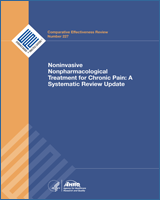From: Results

NCBI Bookshelf. A service of the National Library of Medicine, National Institutes of Health.
| Author, Year, Followup,a Pain Duration, Study Quality | Intervention | Population | Function and Pain Outcomes | Other Outcomes |
|---|---|---|---|---|
Stukstette, 2013261 3 months Duration of pain: Mean 4 years Fair | A. Multidisciplinary treatment program (n=75): 4 group based therapy sessions of 2.5-3 hours duration (time period NR), supervised by a specialized nurse and occupational therapist B. Waiting list (n=72) All patients: 30 minute explanation of written information about OA | A vs. B Age: 60 vs. 58 Female: 18% vs. 16% Mean duration of diagnosis: 4 vs. 4 years Proportion taking opioids: 3% vs. 4% Baseline AUSCAN function (0-36): 21.0 vs. 21.8 Baseline AUSCAN pain (0-20):10.4 vs. 10.2 | A vs. B 3 months AUSCAN function: 18.6 vs. 18.8, adjusted difference 0.5 (95% CI −0.09 to 0.4) AUSCAN pain: 9.4 vs. 9.0, adjusted difference 0.4 (95% CI −0.5 to 1.3) OARSI OMERACT responders: 33% vs. 37%, OR 0.8 (95% CI 0.4 to 1.6) | A vs. B 3 months Patient global assessment (0-100): 60.4 vs. 66.0, adjusted difference −5.2 (95% CI −11.4, 1.0) SF-36 PCS (0-100): 39.8 vs. 39.9, adjusted difference −0.14 (95% CI −1.62 to 1.35) SF-36 MCS (0-100): 50.3 vs. 51.6, adjusted difference 0.27 (95% CI −2.13 to 2.67) |
AUSCAN = Australian Canadian Osteoarthritis Hand Index; OA = osteoarthritis; OARSI-OMERACT = Osteoarthritis Research Society International Outcome Measures in Rheumatology; OR = Odds ratio; SF-36 MCS = Short-Form 36 Questionnaire Mental Component ScoreSF-36 PCS = Short-Form 36 Physical Component Score
Unless otherwise noted, followup time is calculated from the end of the treatment period.
From: Results

NCBI Bookshelf. A service of the National Library of Medicine, National Institutes of Health.